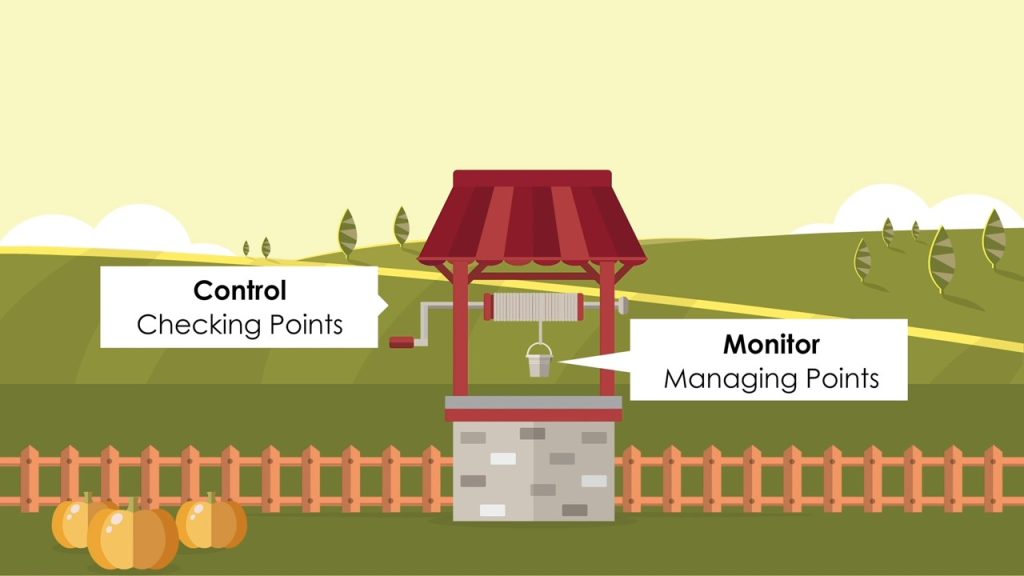Managing Points & Checking Points (MPCP) with Examples

There is a good chance that you haven’t heard of these terms – Managing Points and Checking Points or MPCP.
Now, we will talk about what are ‘MPCP’ and why they are needed, with an example.
In order for you to fully relate to MPCP, you will need to have some background in Daily Work Management and Standard Work.
In an organization, there would be two kinds of activities or goals – Run the Organization (Daily Work Management) and Change the Organization (Transformation or Improvement). For example, if you wish to sustain existing revenue, you would want to maintain or upkeep many process parameters and initiatives through regular management, reviews, support existing products with improvements, provide enabling tools, resources, etc. These fall under Daily Work Management. And when you wish to shift gears and accelerate the business and grow 10x, then you will be looking for Transformation, ie., developing new products, adding new facilities, hiring more people, acquiring new technology, etc.
Managing Points and Checking Points (MPCP) are part of the Daily Work Management routine. They are a set of accountability and responsibility areas for a given role in the organization, aimed mainly at sustaining current level. This could include small improvements to fix issues, address day to day issues, monitor current state of process, ensure there is no deterioration of performance, etc. One of the biggest goals of DWM is to reduce the variability in the output or in other words bring in consistency in the system.
You may be confused about how MPCP is different from Annual Goals or KRAs? Remember that MPCP is for a role and Annual Goals and KRAs are for individuals. Thus it is very unlikely that MPCP would change year on year for role, of course unless the role scope has changed. They are also independent of title.
Now let’s understand Managing Points.
Managing Points are representative of accountability of any given role. For example, a CEO is accountable for business growth, employee engagement, compliance to law of the land, fair treatment to vendors, etc. So he/she has to oversee these aspects. He can’t tell the Board that my Sales Head had a bad year and so we didn’t meet the target. So Managing Points arise from the job description or role description. It also emanates from what the Board or his superiors want him/her to do. In case of any other employee in the organization, Managing Points (MP) are derived from 3 sources – Role description, Manager’s MP and Manager’s CP.
Now let’s move to Checking Points.
Checking Points are demonstrations of responsibility for any given role. These are metrics, tasks or activities that you will do to ensure your accountability is delivered. For example, a kindergarten teacher is accountable to ensure the kids are safe in the classroom. They don’t eat a crayon or anything like that. She will constantly check the classroom for littering, keep close watch on hyperactive kids, etc. So this becomes her responsibility. If I expand the definition of Checking Points (CP) a bit, then it covers input and process parameters, adherence to standard operating procedures (SOP), leading indicators of managing points so that necessary course correction can be done, etc.
A well designed MPCP system for any role should include 2 to 3 CPs for any MP and no more than 5-6 MPs for a role.
Let’s consider one more example of MPCP. Consider you are driving down to pick up your Chairman from the airport. He is visiting your country office for the first time after he took over and you don’t want to mess it up. It’s a 90 mile drive from your factory. You have a driver and a colleague with you. Your Managing Point will be to ensure you reach the airport on-time. Always remember Managing Points have to be measurable parameters. So what will be Checking Points (CP) for this Managing Point (MP)? The departure time from factory, route to be taken, when and where to stop over, average speed, who should be the driver, ensuring the car has all necessary travel documents, etc.,
Each one of the items mentioned here can become your Checking Point but usually the critical ones are prioritized. Some of them, you may choose to delegate to your secretary or empower the driver, in which case it may become their MP. But they are still your accountability.
Let’s say, the route you initially chose has congestion, you will ask the driver to take a different route and not stop-over to compensate for the time lost. Thus you have to measure or assess Checking Points (CP) more often than Managing Points (MPs) to get desired results.
I hope through this example, you were able to understand the importance and linkage between MP and CP.
In a large organization, MPCPs of various roles have to be interlinked. So MPCP plays the vital role of linking job responsibility, process standards and, link to manager or subordinate roles.
At Canopus, we have facilitated the development MPCP and some of most frequently asked questions from participants include:
- How is MPCP different from Annual Goal Sheets?
- How is MPCP different from Projects and Special Assignment?
- Will my MPCPs change every year?
- Can I assign MP or CP to my peers or other departments?
If you have similar questions, feel free to contact me and I’m happy to guide. You can also take self-paced online course Standard Work that will give you templates and many more examples.
#nilakantasrinivasan-j #canopus-business-management-group #B2B-client-centric-growth #MPCP
